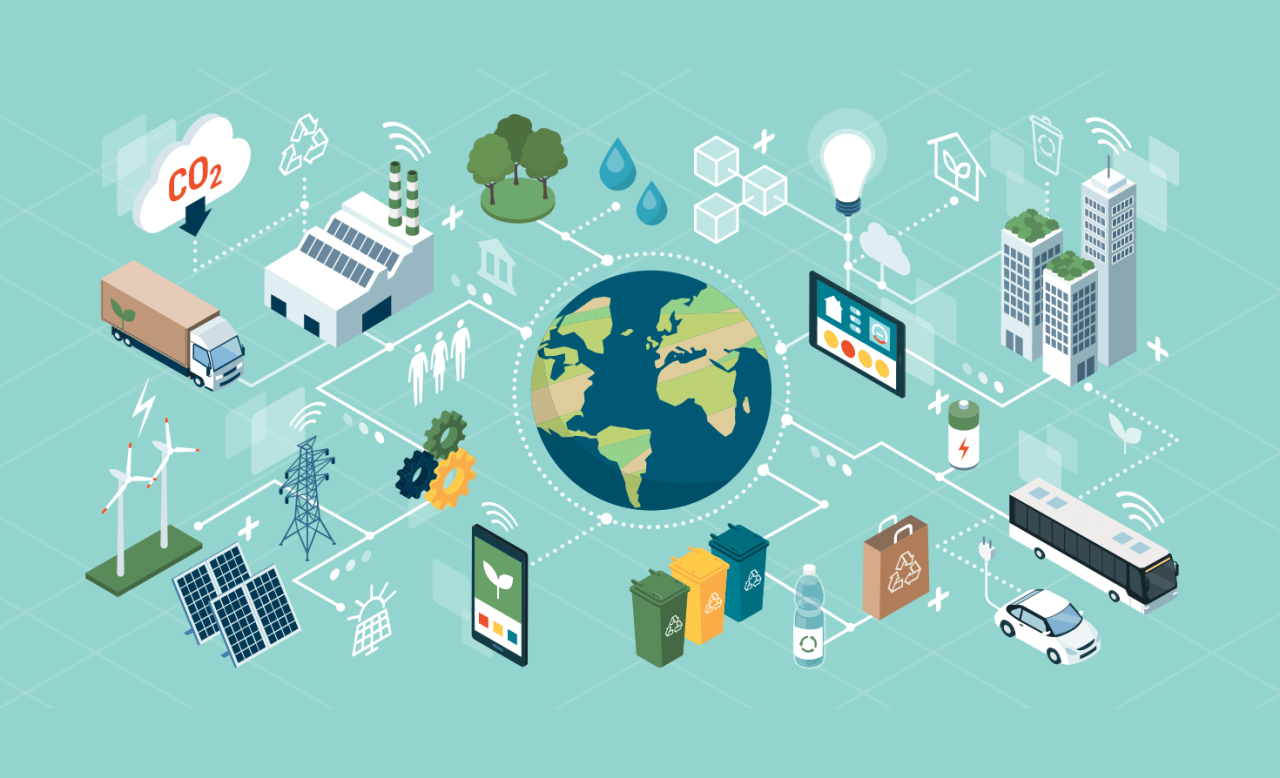Climate Change Technology Companies: Shaping a Sustainable Future
Climate change technology companies are at the forefront of the global effort to mitigate climate change and build a sustainable future. These companies are developing and deploying innovative technologies that […]

Climate change technology companies are at the forefront of the global effort to mitigate climate change and build a sustainable future. These companies are developing and deploying innovative technologies that address the root causes of climate change, from renewable energy sources to carbon capture and storage solutions.
The climate change technology industry is a rapidly growing sector, attracting significant investment and attracting talent from diverse fields. This industry encompasses a wide range of companies, from startups developing cutting-edge technologies to established corporations leading the transition to a low-carbon economy.
The Landscape of Climate Change Technology Companies
The climate change technology industry is rapidly growing, with companies developing innovative solutions to address the urgent need to reduce greenhouse gas emissions and mitigate the impacts of climate change. This industry encompasses a diverse range of sectors, each focusing on different aspects of the climate challenge.
Key Sectors within the Climate Change Technology Industry
This sector is characterized by its focus on developing and deploying technologies that reduce greenhouse gas emissions, improve energy efficiency, and promote sustainable practices.
- Renewable Energy: Companies in this sector develop and deploy renewable energy sources, such as solar, wind, hydro, geothermal, and biomass. Major players include companies like Tesla, Vestas, and First Solar.
- Energy Storage: These companies focus on developing and deploying energy storage solutions, such as batteries, pumped hydro, and compressed air energy storage, to improve grid reliability and enable the integration of renewable energy sources. Prominent companies in this sector include Tesla, LG Chem, and Fluence.
- Energy Efficiency: Companies in this sector develop technologies and solutions that improve energy efficiency in buildings, transportation, and industrial processes. Notable examples include Siemens, Honeywell, and Johnson Controls.
- Carbon Capture and Storage (CCS): Companies in this sector develop and deploy technologies that capture and store carbon dioxide emissions from industrial processes and power plants. Leading players include Global CCS Institute, Climeworks, and Carbon Engineering.
- Sustainable Agriculture: This sector encompasses companies developing technologies and practices that improve agricultural productivity while reducing environmental impacts. Examples include Verbio, ADM, and Cargill.
- Climate-Smart Finance: These companies provide financial services and investments that support climate-friendly projects and businesses. Key players include Climate Policy Initiative, Climate Bonds Initiative, and the Green Climate Fund.
Major Players and Their Areas of Focus
Several companies have emerged as leaders in the climate change technology industry, each with a distinct area of focus.
- Tesla: Known for its electric vehicles, Tesla also develops energy storage solutions, such as the Powerwall home battery and the Megapack utility-scale battery. Tesla’s focus is on accelerating the transition to sustainable energy.
- Vestas: A global leader in wind turbine manufacturing, Vestas plays a significant role in the development of wind energy projects worldwide. Vestas’s focus is on providing clean and sustainable energy solutions.
- Siemens: A technology powerhouse, Siemens provides a wide range of solutions for energy efficiency, renewable energy, and smart grids. Siemens’s focus is on enabling a sustainable energy future.
- Climeworks: This company specializes in direct air capture technology, which removes carbon dioxide directly from the atmosphere. Climeworks’s focus is on mitigating climate change by removing CO2 from the air.
- Climate Policy Initiative: This non-profit organization works to advance climate policy and finance, supporting the development and implementation of climate-friendly projects. Climate Policy Initiative’s focus is on driving climate action through policy and finance.
Historical Overview of the Climate Change Technology Industry
The climate change technology industry has evolved significantly over the past few decades, driven by growing awareness of the climate crisis and technological advancements.
- Early Stages (1970s-1990s): The early stages of the industry were marked by the development of solar and wind energy technologies, primarily driven by government incentives and research funding.
- Growth and Expansion (2000s-2010s): The industry experienced significant growth in the 2000s and 2010s, driven by factors such as declining costs of renewable energy technologies, increasing government support, and growing investor interest.
- Maturation and Diversification (2010s-Present): The industry has continued to mature and diversify in recent years, with the emergence of new technologies and solutions, such as energy storage, carbon capture, and climate-smart finance. The industry is now characterized by a broader range of players, including startups, established corporations, and non-profit organizations.
Key Technologies and Innovations: Climate Change Technology Companies
The fight against climate change requires a multi-pronged approach, and technological advancements are playing a crucial role in mitigating its effects. This section explores some of the most promising technologies and innovations that are driving progress in renewable energy, carbon capture, and sustainable agriculture.
Renewable Energy
Renewable energy sources, like solar, wind, and hydropower, offer a sustainable alternative to fossil fuels. These technologies harness naturally replenishing resources, reducing greenhouse gas emissions and promoting a cleaner energy future.
Solar Energy
Solar energy, the conversion of sunlight into electricity, is a rapidly growing sector.
- Photovoltaic (PV) solar cells, the most common type, use semiconductors to directly convert sunlight into electricity. The efficiency of PV cells has been steadily increasing, with advancements in materials and manufacturing techniques.
- Concentrated solar power (CSP) systems use mirrors to concentrate sunlight, heating a fluid that drives a turbine to generate electricity. CSP systems are particularly well-suited for large-scale power generation, and they can store thermal energy for use even when the sun is not shining.
Wind Energy
Wind energy, harnessing the kinetic energy of wind to generate electricity, is another significant renewable energy source.
- Wind turbines, the primary technology for wind energy generation, have become increasingly efficient and cost-effective. Advancements in blade design, control systems, and materials have led to significant improvements in energy output and durability.
- Offshore wind farms, located in deeper waters, offer greater wind resources and less visual impact than onshore farms. These farms are becoming increasingly popular, particularly in coastal regions.
Hydropower
Hydropower, harnessing the energy of flowing water to generate electricity, is a mature and reliable renewable energy source.
- Traditional hydropower plants, using dams to create reservoirs, have been a major source of electricity for decades. However, the environmental impact of dams, particularly on river ecosystems, has raised concerns.
- Run-of-river hydropower plants, which do not require large reservoirs, offer a more environmentally friendly alternative. These plants generate electricity from the natural flow of rivers, minimizing disruption to the ecosystem.
Carbon Capture and Storage, Climate change technology companies
Carbon capture and storage (CCS) technologies aim to remove carbon dioxide (CO2) from industrial processes or directly from the atmosphere and store it underground.
- Post-combustion capture, the most common CCS technology, involves capturing CO2 from flue gases after combustion. This technology is often used in power plants and industrial facilities.
- Pre-combustion capture involves capturing CO2 before combustion. This technology is typically used in industrial processes that produce hydrogen or syngas.
- Direct air capture (DAC) technologies remove CO2 directly from the atmosphere. While still in its early stages, DAC has the potential to play a significant role in mitigating climate change by removing CO2 from the atmosphere.
Sustainable Agriculture
Sustainable agriculture practices aim to produce food while minimizing environmental impact.
- No-till farming, a practice that avoids tilling the soil, helps reduce soil erosion and improve soil health. This practice also reduces greenhouse gas emissions from soil disturbance.
- Cover cropping, planting non-cash crops between cash crops, helps improve soil fertility, reduce erosion, and control pests and diseases.
- Precision agriculture, using technology to optimize crop yields and resource use, can reduce fertilizer and pesticide use, minimizing environmental impact.
Business Models and Investment Opportunities

The climate change technology sector is attracting significant interest from investors seeking to capitalize on the growing demand for sustainable solutions. This section delves into the diverse business models employed by these companies and explores the key investment trends and opportunities within this dynamic space.
Business Models
Climate change technology companies employ a variety of business models, reflecting the diverse nature of their solutions and target markets.
- Product Sales: This model involves developing and selling tangible products that directly address climate change, such as solar panels, electric vehicles, or carbon capture technologies. Companies in this category generate revenue through the sale of their products, often accompanied by ongoing maintenance or support services.
- Service Provision: Some companies offer services that help businesses and individuals reduce their environmental impact. This includes energy efficiency audits, renewable energy consulting, carbon offsetting programs, or waste management solutions. Revenue is generated through service fees or subscription models.
- Software-as-a-Service (SaaS): Many climate change technology companies develop software platforms that provide data analytics, monitoring, and management tools for sustainability initiatives. These SaaS models generate revenue through subscription fees based on usage or features.
- Data and Analytics: Companies specializing in data analytics play a crucial role in providing insights into climate change impacts and informing decision-making. They offer data-driven solutions for carbon accounting, risk assessment, and climate modeling, generating revenue through data licensing, consulting services, or subscriptions.
- Investment and Financing: Some companies focus on providing financial solutions for climate change mitigation and adaptation. These models include green bonds, impact investing funds, or carbon finance projects, generating revenue through investment returns or transaction fees.
Investment Trends and Opportunities
The climate change technology sector is experiencing a surge in investment, driven by factors such as increasing awareness of climate risks, government policies promoting sustainability, and the growing demand for innovative solutions.
- Renewable Energy: Investment in renewable energy technologies, such as solar, wind, and geothermal power, continues to be a significant trend. This sector offers attractive returns, driven by declining costs and government incentives.
- Energy Efficiency: Companies developing technologies and solutions for energy efficiency, including building automation, smart grids, and energy management systems, are attracting considerable investment. The focus on reducing energy consumption and improving efficiency is driving demand for these solutions.
- Carbon Capture and Storage (CCS): CCS technologies, aimed at capturing and storing carbon dioxide emissions, are gaining momentum as a potential solution for mitigating climate change. Investment in CCS is expected to grow as the technology matures and becomes more cost-effective.
- Climate Adaptation: With the increasing impacts of climate change, investment in adaptation technologies, such as flood control systems, drought-resistant crops, and water management solutions, is gaining traction. These solutions offer opportunities for both risk mitigation and business innovation.
- Sustainable Agriculture: Investment in sustainable agriculture practices, including precision farming, organic farming, and regenerative agriculture, is growing as the demand for environmentally friendly food production increases. This sector offers opportunities for both technological innovation and market disruption.
Challenges and Risks
Investing in climate change technology presents both opportunities and challenges.
- Early Stage Technology: Many climate change technologies are still in their early stages of development, posing challenges related to scaling, commercialization, and long-term viability.
- Regulatory Uncertainty: The regulatory landscape for climate change technologies is evolving rapidly, creating uncertainty for investors. Changes in government policies, carbon pricing mechanisms, and environmental regulations can impact the profitability of these companies.
- Market Adoption: The adoption of climate change technologies can be slow due to factors such as cost, infrastructure limitations, and consumer preferences. This can impact the growth prospects and returns for investors.
- Competition: The climate change technology sector is becoming increasingly competitive, with new entrants and established companies vying for market share. This competition can pressure profit margins and require companies to constantly innovate and differentiate themselves.
Impact and Policy Considerations
Climate change technology holds immense potential to mitigate climate change and achieve sustainability goals. These technologies are not only instrumental in reducing greenhouse gas emissions but also in adapting to the inevitable effects of climate change. However, their effective deployment and widespread adoption are contingent upon supportive government policies and regulations, as well as a careful consideration of their ethical implications and social impacts.
The Potential Impact of Climate Change Technology
The impact of climate change technology can be categorized into two key areas: mitigation and adaptation.
Mitigation
Climate change technology plays a crucial role in mitigating climate change by reducing greenhouse gas emissions. Examples of such technologies include:
- Renewable energy technologies: Solar, wind, geothermal, and hydropower are all key technologies for replacing fossil fuels and reducing carbon emissions. The global renewable energy market is experiencing rapid growth, driven by factors such as declining costs, technological advancements, and supportive government policies.
- Energy efficiency technologies: These technologies help reduce energy consumption in buildings, transportation, and industry, thereby lowering greenhouse gas emissions. Examples include LED lighting, smart grids, and energy-efficient appliances.
- Carbon capture and storage (CCS): This technology captures carbon dioxide emissions from industrial processes and power plants and stores them underground, preventing them from entering the atmosphere. CCS is considered a promising technology for reducing emissions from hard-to-abate sectors like steel and cement production.
- Sustainable agriculture practices: These practices aim to reduce greenhouse gas emissions from agriculture, which is a significant source of emissions. Examples include no-till farming, agroforestry, and improved livestock management.
Adaptation
Climate change technology also plays a vital role in helping societies adapt to the inevitable effects of climate change. Examples of such technologies include:
- Climate-resilient infrastructure: This includes infrastructure designed to withstand extreme weather events such as floods, droughts, and heat waves. Examples include seawalls, flood-resistant buildings, and drought-resistant crops.
- Water management technologies: These technologies help manage water resources more efficiently, particularly in regions facing water scarcity due to climate change. Examples include desalination plants, water-efficient irrigation systems, and rainwater harvesting systems.
- Early warning systems: These systems provide timely warnings about extreme weather events, enabling people to take necessary precautions and reduce potential damage. Examples include weather radar systems, flood monitoring systems, and heat wave warning systems.
Future Trends and Challenges

The climate change technology industry is rapidly evolving, driven by increasing awareness of the urgency of addressing climate change and the emergence of innovative solutions. The future holds both exciting opportunities and significant challenges for this sector.
Emerging Technologies and Their Potential
The development of emerging technologies is crucial for tackling climate change. These technologies have the potential to significantly reduce greenhouse gas emissions, enhance energy efficiency, and adapt to the impacts of climate change.
- Artificial Intelligence (AI): AI can optimize energy consumption in buildings and industries, improve the efficiency of renewable energy systems, and accelerate the development of new climate-friendly technologies. For example, AI-powered systems can analyze vast amounts of data to identify patterns and optimize energy usage in real-time, reducing energy waste and emissions.
- Carbon Capture and Storage (CCS): CCS technologies capture carbon dioxide emissions from industrial processes and power plants and store them underground, preventing them from entering the atmosphere. This technology is particularly important for industries that are difficult to decarbonize, such as cement and steel production.
- Biotechnology: Biotechnology offers innovative solutions for sustainable agriculture, biofuels, and carbon sequestration. For example, genetically engineered crops can be more resilient to climate change and require less water and fertilizer, reducing their environmental impact.
- Advanced Materials: Advanced materials with improved properties, such as lightweight and durable materials, can reduce energy consumption in transportation and construction. For example, using lighter materials in vehicles can improve fuel efficiency and reduce emissions.
Last Recap

The future of climate change technology is bright, with continued innovation and investment driving progress towards a sustainable future. The companies in this sector are playing a critical role in shaping the world’s response to climate change, and their efforts are essential for achieving a more sustainable and resilient planet.
Climate change technology companies are constantly innovating to find solutions, and one key area is the development of advanced AI models. These models require vast amounts of data to be trained effectively, which is where the invisible technologies advanced AI data trainer comes in.
This technology can help streamline the data training process, allowing climate change technology companies to build more sophisticated AI solutions that can help us combat the effects of climate change.





